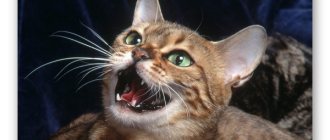Holding a cat like a dog is not a very pleasant situation for the cats themselves. This is why it can be difficult to lift and hold.
But there are times when you need to do this, such as to put him in a carrier or during a vet visit, and it's important to do it correctly so that your cat doesn't get hurt or do this to you, perhaps because she's scared. So, let's look at some tips together on how to pick up a cat without scaring it.
Adviсe
If there is no other way out and you need to take the cat by the scruff of the neck, this must be done very carefully so as not to cause any inconvenience to the animal. It is worth monitoring his reaction; movements should be confident, skillful, and not clumsy, because cats are very sensitive to the movements and actions of their owner and other people around them. Wariness, fear, and concern for the cat should be left for the future, when the job is done. If the cat senses this in the owner, it will begin to wriggle out and try to escape, thereby hurting itself. You need to take your pet correctly. To begin with, you should feel for a good fold on the back of the neck so that it is convenient to grab it. Next, slowly lift the cat, but only a little, to look at the reaction. At this moment, the cat's paws should still touch the ground.
If the animal is frozen and does not show aggression, you can slowly continue to raise it. It is very important to grab only a good, large fold, since if the hand grabs little skin, the cat may slip out.
https://youtube.com/watch?v=aursPvtW5b8
Second phase
The first stage of acquaintance requires caution, since the cat can attack a person and scratch him. Check in first, demonstrating friendliness and respect
To find out the cat's mood, place a palm above its head. If he nuzzles or purrs, he allows himself to be petted.
If the cat rubs against his legs and purrs, then perhaps he is bored and wants attention. Unconditional trust is evidenced by the fact that the animal sits comfortably on the person's lap.
A cat rubbing against its legs is a good sign
Next, they ensure that the cat climbs onto her lap on her own.
Then they carefully teach her to limit her movements and lift her into her arms. At first, to avoid injuries in the form of scratches and bites, wear long sleeves and do not walk with bare legs or bare feet.
You can't look a cat in the eyes
When the cat begins to calmly perceive the presence of the new owner, you can spend some time with her - for example, 30-60 minutes, for example, reading a book. And the cat is offered toys that are sold in a pet store.
Choosing a toy for a cat
Fear of touch takes a long time to heal, but the new owner must be patient. At first, the cat is not picked up and contact is not required if the animal seeks privacy. Light touches are only possible if the pet itself approaches the person.
Nervous excitement should always be a signal to stop contact. And it manifests itself like this:
- the tail trembles;
- ears drooped towards the head;
- shoulders and limbs tense;
- pupils are dilated.
Full pupils and pinched ears are a sign of tension
You should not immediately try to pick up the cat, as this will most likely result in injuries - bites and scratches.
First, the cat is accustomed to your hand by placing it palm down on the floor; you can place the cat’s favorite toy nearby. You need to wait until the cat comes up and rubs itself on your arm or leg. In this way, she wants to make sure that the object present is not dangerous. If a person initiates contact, the animal may respond with an attack.
If the cat attacks, pick him up early
If the pet has given the go-ahead, the palm is slowly raised to eye level and held in this position for a while. Then they begin slow stroking. You need to stop before the cat gets tired of close contact with a person.
How to properly hold a cat in your arms
When holding your cat close to your chest, be guided by its habits and reactions. Every pet and owner is unique, and so will your relationship. However, there are a number of universal recommendations that will help you and your cat understand each other and enjoy communication.
- Hold your pet lightly against your chest, with its head and neck raised up - this is how the animal is most comfortable.
- The cat should sit on one of your hands, and it is best to support it under the chest with the other hand. If she doesn’t like it that way, she will take a comfortable position herself - the main thing is not to interfere with her initiative.
- Never lift your pet by the scruff of the neck! A mother cat carries her kittens this way, but this is only possible due to the small weight of the kitten. An adult animal weighs much more, so it will be painful and uncomfortable.
It is better not to handle newborn kittens at all - there is a risk of skeletal deformation. In addition, some cats are capable of abandoning their cubs due to the foreign smell.
Why you can't drag a cat by the scruff of the neck
Thanks to the innate reflex, the kitten, when the mother cat drags it, grabbing it by the scruff of the neck, relaxes its body, and also tucks its hind legs and tail. Temporary paralysis is explained by pinching of a bundle of nerves located on the back of the neck. It is much easier for a cat to move a relaxed and non-resisting baby to a safe place. During carrying, the cat does not cause any harm or pain to its cub. The scruff of a cat's neck is considered the most painless part of the body. However, adult pets cannot be lifted or dragged by the scruff of the neck.
Cats drag kittens, biting the scruff of the neck with their teeth
Reasons are physiological
The ban on lifting an adult cat by the scruff of the neck is explained by physiology:
- A mature animal's skin is rougher and less elastic than that of a small kitten. The skin does not stretch well and may even tear.
- The neck muscles may become damaged (stretched or torn), since the pet is already quite heavy.
- The rough skin becomes very tight and puts pressure on the throat, making it difficult for the cat to breathe.
- A sharp grab by the scruff of the neck can even damage the spine (in rare cases).
Animal instincts
Not every four-legged pet enjoys the fact that its owner limits its movements. There are some cats that resist with all their might anyone who tries to pick them up. And once in the strong hands of the owner, they try to escape as quickly as possible.
Everyone is familiar with the phrase: “The cat walks on its own.” It is based on natural instincts that have been preserved in their genotype even after a large amount of time since their domestication. This is the main reason why pets don’t like being in their owner’s hands.
Cat owners strive to pick up and pet their pet as often as possible. To please both the person and the animal, you should examine in detail the question of how to properly hold a cat in your arms.
Harm to a person
Don’t forget that in cases where the cat gets really angry, he will break free and scratch “from the heart”, trying to escape and defend himself. If the pet is large, all this can end badly not only for him, but also for his overly self-confident owner.
There have been cases when cats simply tore people's hands to the bone. Therefore, in cases where the cat really needs to be restrained using a “snake grip”, it is advisable to take care of having strong and rough gloves with a long neck! They will make the fixation safe for both the pet and its owner.
Features of some breeds
A cat's dislike for physical contact may be due to the characteristics of its breed. British Shorthair and Scottish Fold and Straight cats often behave very independently, which is also reflected in their reluctance to sit in their hands. The phlegmatic British and Scots do not really need affection, they are self-sufficient and usually do not go on their own, they only allow themselves to be stroked. Wayward Maine Coons can also exhibit similar qualities. Among cats of these breeds there are also more sociable individuals, but exceptions only confirm the rule.
Interpretation according to zodiac signs
You can figure out and understand why a small gray kitten is dreaming based on the interpretation of the dream according to the dreamers’ zodiac signs:
- Aries - deterioration of health;
- Taurus - profit;
- Gemini - short-lived luck;
- Cancer - vain dreams;
- Leo - financial difficulties;
- Virgo - new apartment, house;
- Libra is a disease;
- Scorpio - brilliant success;
- Sagittarius - movement towards the goal;
- Capricorn - financial gain;
- Aquarius - lie;
- Pisces is a new addition to the family.
In addition to the signs of the Zodiac, you can pay attention to other details of the dream, such as the days of the week, the condition of the animal, and its behavior. There are several dream interpreters who have differing opinions about the meaning of sleeping with a gray cutie.
Walks
Some owners prefer to keep their pets at home, not allowing the cats to get acquainted with the outside world. However, it has long been known that walking strengthens the immune system, so to the question “should I walk my cat” there is only one answer: yes.
Before you start walking your pet, you need to protect it:
- Only vaccinated animals are allowed for walking;
- During walks, the cat must wear an anti-parasitic collar;
- There is no need to walk your cat in damp and cold weather;
- After visiting the yard, the cat needs to wash its paws and inspect the animal for ticks.
If the walk involves wearing a special harness, then the cat should get used to such an accessory at home. You can walk your pet only when it moves freely around the apartment in its equipment, without trying to take it off.
Walk
Choose quiet and clean lawns for walks. It is unlikely that a cat will benefit from visiting a paved area of the yard or meeting dogs.
You should not let your cat near unfamiliar animals. Stray animals are often carriers of diseases, even if they appear healthy.
Unsterilized pets should not be left unattended. Not only will he try to procreate, but he may also pick up viruses that are inappropriate for a domestic cat.
Why doesn't a cat like to be held?
Animal psychologists say that if domestic cats could choose, most would prefer to never be picked up or picked up. Even if a pet trusts a person, he still feels complete comfort only by standing with all four paws on the ground. So you shouldn’t be surprised if your pet protests against “handles” - such behavior for cats is more the norm than a deviation.
How to properly hold a cat in your arms
Reasons why a cat does not want to be held:
- Distraction. If a cat sees something interesting - a bird outside the window or a moving shadow - it will want to explore what it saw and will jump from your hands.
- Strong smell. A cat’s sense of smell is 14 times more sensitive than a human’s: a person’s brain has 5-20 million cells responsible for sensing and recognizing odors, while a cat has 60-80 million. The animal does not like any strong aromas, especially spices, citrus fruits, perfumes, washing powder , alcohol. You can learn more about what smell cats don’t like in our separate article.
A cat's nose is many times more sensitive than a human's
- Fright. Frightened by screams, sudden movements or sounds, or strangers, the cat will try to hide in a secluded place, so it will not let itself into your hands or will try to escape.
- Fear of heights. As already mentioned, a cat is completely calm only when standing on a hard, level surface. Raised above the ground, she may be afraid of losing her balance and falling.
- Street past. If you pick up a pet on the street, it has not grown up accustomed to affection, and attempts to touch it may be perceived as a threat to its own safety.
The street cat sees danger everywhere
- Resentment. Cats have long memories. If you or the previous owner beat the cat or shouted at it, the animal will refuse to come into your arms because of past grievances.
- Strangers or children. The animal may not trust strangers, and may be afraid of children.
- Features of the breed. Short-haired British cats and fold-eared cats especially do not like to be handled; their breed is characterized by independence and restraint. Maine Coons can also refuse contact from their owners. The most sociable are mongrel pets who have no street history.
- Diseases of the musculoskeletal system. A cat that suffers from arthritis, for example, is not always comfortable in a person's arms.
How to recognize arthritis in cats
Of course, the character traits of a particular animal can also determine its love or dislike of close tactile contact.
Don't you dare squeeze my majesty!
There are closed, self-sufficient or fearful cats that from birth cannot tolerate physical contact and do not like to communicate and play. It also happens that the animal simply does not show the initiative, but does not mind if it is picked up and stroked. And sometimes a cat simply does not accept a family member or guest, and this “brutal verdict” is not subject to appeal. If you wish, you can tame an animal and instill a sense of trust in it, but you will have to spend a lot of time and labor. The most important thing is not to force the cat into affection and physical contact.
Ways to train a kitten
Sometimes you can’t just calmly sit a kitten in your arms, because it gets scared and, even when it recognizes the person, continues to struggle. In order for a pet to be willingly given into the owner’s hands, it is necessary to accustom it to this, if it itself does not show a desire to actively make contact. As soon as the kitten realizes that communicating with the owner, when he takes him in his hands, brings him pleasure, the baby himself will strive to cuddle the person. Be sure to hold the kitten correctly, caress the pet and talk calmly to it. It’s very good if the cat starts playing while in your arms.
shutterstock
The kitten will quickly stop being afraid to be handled if you use one of the training methods below.
Using the characteristics of animal physiology. After the kitten has eaten well, it begins to feel sleepy, since maximum energy is spent on digesting food. If the animal is warm and comfortable at this moment, it will begin to experience special pleasure. The owner may well provide the pet with the illusion that he is lying next to his mother if he picks up a well-fed, dozing kitten and cuddles him, but without squeezing. Gradually, the baby will get used to the fact that sitting in your arms is very pleasant and safe. Talk. Monotonous, affectionate conversation with the kitten gradually begins to relax it
At this moment, the owner has the opportunity to gently stroke the pet behind the ear or in the throat area. If the kitten reacted calmly to such affection, you need to place your palms on its sides
If the baby does not break free here, he is carefully picked up. When the kitten tries to escape, you should not restrain it by force. Such sessions must be repeated several times a day, until the baby agrees to stay on the owner’s lap. Lure with a treat. This method is most suitable for kittens who are particularly freedom-loving and cannot combine being held in their arms with pleasant sensations. Using a treat, the owner lures the pet onto his lap. While the kitten is eating the treat, you need to stroke it on the back, but under no circumstances hold it by force. Gradually, the baby will get used to the fact that it is pleasant to be held and will actively seek the company of the owner. Overcoming the fear of heights. As strange as it may sound, some cats are terrified of heights. Because of this, when a kitten is picked up incorrectly and he perceives what is happening as floating in the air, he experiences a severe shock. This phenomenon can be prevented simply by starting to hold the baby correctly. Then his fear of hands will go away. You need to take the kitten with one hand under the armpits, and place the other under its hind legs. After this, the baby should be held close to you, but not squeezed. If the fear is panicky, then first you need to accustom the kitten to your hands while sitting on the floor. Training in the game. This method is suitable for active kittens who are not yet ready to exchange free time for affection. When playing with such a baby with a toy, you should gradually pull it onto your lap. After the kitten jumps into your arms, you need to let him catch the toy here and enjoy the catch. While the kitten is playing in your arms, you can pet it. Gradually, such games with jumping into hands will lead to the fact that the animal will not only completely get used to the hands, but will not be able to do without affection and close contact with a person. With this nature of the pet, you should often allow the cat to sit in your arms while playing with the owner.
The choice of method depends on the individual characteristics of the kitten, and each owner must evaluate for himself which method is optimal in his case. In principle, accustoming a kitten to affection cannot fail, you just don’t need to stubbornly follow a method that is not suitable, but need to be creative in your approach.
shutterstock
Is it possible to tame an adult cat to a new owner?
A cat tolerates a change of owner more easily than a dog. The exception is socially oriented breeds, for example, Oriental Siamese. They will gradually become affectionate with their new owners, but the first one is the only one for life.
The best way to train, even for a sexually mature individual, is not food, but play. First, an adult cat must get used to the territory. It is better to leave your pet to explore its new home on its own, and after a while offer some food from your hands. Just like a treat. At the same time, do not forget to talk measuredly, but not to stroke.
As soon as the cat gets used to it a little, you can:
- lightly scratch a chair or furniture - so that the cat reacts to the sound near the owner;
- roll a ball or ball of wool near you, inviting you to play;
- “drive” a candy wrapper.
The cat quickly joins the game. After a while, you should again give a piece of food from your hand and praise it.
You can't hit a cat!
Cats are not used to obeying, therefore, their owners often have difficulty raising their pets. The biggest mistake in raising wayward animals is the use of physical force. You can't hit cats. This method cannot solve the problem; you will only lose her trust. The animal will begin to associate you with pain.
If you punish a cat for bad behavior, the results will only be visible the first time. Over time, such “education” ceases to work completely.
Aggression for educational purposes on the part of the owner is assessed by the animal in its own way; the cat may lose its pride and you will no longer have a normal relationship with your pets.
How to properly hold a cat in your arms and pick up an animal so as not to cause inconvenience?
How many cat owners, when picking them up, think about the fact that their inept actions could cause them discomfort, and in some cases, harm? Meanwhile, you need to be able to do it correctly. To ensure that the pet does not break free, calmly walks into the owner’s arms and gladly receives affection from him, you need to take into account several nuances. Each owner of such a pet is recommended to know not only how to properly hold a cat in his arms, but also how he should be picked up from the floor and what actions should be avoided.
"Chokehold"
There is another reason why adult pets should not be dragged by the scruff of the neck. The fact is that when the skin of the neck is stretched, the pet cannot breathe normally. Of course, for a cat to suffocate to death, it needs to be “carried” like this for several hours in a row, but still there is nothing good in this state.
Choking, the animal begins to panic, twitch, trying to escape from the “choke hold”. The result is the same injuries, damage to the skin and muscle tissue. By the way, there have been cases when particularly strong and “irreconcilable” cats, whom the owners tried to “restrain” by lifting them by the scruff of the neck, managed to injure their necks! Sometimes it even ends in the death of the animal, and therefore it is better not to risk it.
At what age should you start raising a kitten?
Raising a kitten should begin before two months from birth. Usually during this period the baby is still in the nursery or with the breeder, as he needs his mother and milk feeding. The cat instills basic skills and rules of behavior. The breeder teaches the kitten to toilet, and the mother teaches other cat skills. With such a kitten there are fewer problems, it is easier to train them to the new requirements of the owners. The situation is much more complicated with kittens found on the street - these are ill-mannered cats that have not received the necessary skills for living with humans, but the situation can be corrected.
One of the main requirements is to let the kitten get stronger, get good health and immunity. Caring for an animal will give it good health and proper psyche
You need to start accustoming him to the tray from the very first days, but with caution, without using physical force in case of mistakes
At the age of 3-4 months, the kitten is very active, plays a lot, plays pranks and even misbehaves. During this period, it is worth showing rigor and patience. You need to demonstrate a firm tone, but without punishment or violence.
At approximately six months, puberty begins. This applies to both male and female cats. Under the influence of hormones, the pet's character changes, not always for the better, the animal becomes disobedient. But everything returns to normal around the age of one year, when the kitten becomes a young adult cat.
Risk of developing mental problems
Not at first glance, the subtitle is completely crazy: “How can carrying a cat be connected with mental illnesses?” It turns out that this is quite possible. And to understand this, you need to go back to the kittens, which the mother cat can drag around the house from time to time.
At this time, the nerve endings are pinched under the skin, making babies become calmer and more obedient. Adult cats evaluate this technique as an attempt to establish their superiority. These animals are very self-sufficient and independent, and therefore constant psychological pressure can cause the development of neuroses and other pathologies of the nervous system. At best, the pet will become very nervous and irritable, simultaneously acquiring the habit of marking all vertical surfaces.
Other factors of a psychological nature
In addition, in a “suspended” state, the cat feels defenseless, unable to withstand possible danger. This also weakens the animal’s psyche, turning it into a real neurasthenic.
Finally, after such actions, cats often feel humiliated and insulted, which is why they completely lose trust in their owner. Such a pet will either run away from home at the first opportunity, or will constantly “show dissatisfaction” by peeing and pooping all over the apartment. And in this case, regaining the trust of the offended animal is either very difficult or completely impossible.
Features of some individual breeds: Sphynx, Scottish cats and others
Some breeds require special care.
British and Scottish cats
The British and Scots need special attention to their ears - they should always be clean, with trimmed tassels. It is also necessary to pay special attention to their coat - it is recommended to comb them at least twice a week, for at least half an hour, using massaging movements. By the way, these are the only representatives of short-haired cats who like to be combed against the grain.
Scottish fold kitten
Sphinxes
These cats are hairless and require special care. Firstly, they sweat, so they need to be wiped with a damp sponge at least once a day. Secondly, kittens of this breed do not have eyelashes, so something often gets into their eyes - they are washed either with black tea or special eye drops. Thirdly, the ears of sphinxes must be inspected daily and cleaned at the slightest hint of dirt. It is also necessary to remove hairs from the skin of sphinxes if they appear.
A very small Don Sphynx kitten
Long-haired breeds
If you have a Siberian or Persian cat, Maine Coon or other kitten with increased hairiness, you will have to purchase a lot of different scratchers and brushes, and devote enough time to combing procedures. So, a mitten brush will remove lost hairs, a slicker will remove excess undercoat, a sparse comb will comb out the main coat and massage your pet, a frequent brush will be useful for the softest places - the tummy, the inside of the paws and the area under the tail. Also, representatives of long-haired breeds often need additional vitamins, a sign of which can be active shedding in the off-season.
Red little Maine Coon kitten
Short-haired breeds
This type includes Siamese, exotic, Abyssinian, Thai and representatives of many other breeds. They do not require special care - just regularly clean their ears, teeth and eyes, comb them periodically and do not forget about anti-parasitic measures.
Satisfied kitten lies on the sofa
From a kitten to an adult cat is less than a year, so be prepared for the rapid transformation of a cute fluffy ball that requires your attention and care into a large imposing animal that, despite its apparent independence, will still be entirely dependent on you. And in return for your efforts you will receive feline gratitude, warmth and purr-purr-purr.
Healthy diet
One of the main points of care is regular feeding of foods that are safe for cats and provide them with the necessary substances and vitamins. Balancing the furry diet will ensure their health, activity, and long life.
One of the common mistakes of cat owners is an irresponsible attitude to their pet’s nutrition. Many people believe that it is enough to feed the animal human food from their table - and this leads to serious illnesses in the pet.
When preparing a cat's diet, you need to take into account the recommendations of veterinarians.
- Ready-made food should be combined with moist, nutritious cereals and herbs.
- We must not forget about the constant presence of water in the animal’s bowl.
- Wet and ready-made food should be chosen only from good brands, “elite” or “premium” class. Economy class meals can be used extremely rarely, in the absence of a better option.
- For the normal development of apartment cats, the presence of good quality meat and fish products in the diet is of great importance.
- You can also feed your pet homemade products - boiled lean meat, fish, nutritious cereals, fermented milk products, vegetables (raw and boiled). By percentage, protein should be present most in the diet.
The healthiest foods that cats definitely need are lean meat, offal, buckwheat or barley porridge, sea fish fillet, vegetables such as zucchini and carrots. Eggs should also be given.
Aggression towards another animal
A new owner may show aggression towards a pet that already lived in the house. In such cases, the cats are placed in different corners for a while, preventing their contact. This continues until the smell of the new pet becomes part of the atmosphere of the home. Then the cats are introduced again.
But even after establishing contact with the old-timer, care must be taken to ensure that the animals have different corners for resting and feeding. It is also necessary to buy trays for each four-legged “family member”. To avoid incidents of predatory aggression, it is necessary to provide an outlet for these instincts. To do this, it is advisable to also purchase a scratching post.
Foundlings can be aggressive towards old-timers and vice versa
Taming a cat is a rather difficult task and the undertaking does not always end in victory. It will take up to 6 weeks to domesticate a kitten, sometimes more. With older cats, the process can take years. Therefore, you should not grieve if you failed to tame the animal.
But having achieved success, it is important to remember: a wild cat will still spend most of its time alone
Setting up a feeding area
The kitten definitely needs a permanent place that will serve as a dining room. Traditionally, it is located in the kitchen, in some secluded corner. However, it should be noted that neither the bowls nor the calmly dining animal should get in the way
Particular attention should be paid to the menu. Always have fresh water available
You can place a bowl of dry food next to the drinking bowl - the cat will be sure that at any moment she can go to the kitchen and have a snack. In the morning and evening, when you can throw away the leftovers and wash the dishes, you can give wet food. Moreover, it is desirable that it be of the same brand as dry. This will make your pet’s diet as balanced as possible. Of course, even the most delicious and expensive food will become boring, so you will have to change not only the types, but also the manufacturers. Also, do not forget to wash the bowl, even if the food is only dry.











